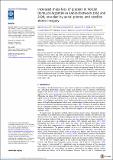Increased mass loss of glaciers in Volcán Domuyo (Argentinian Andes) between 1962 and 2020, revealed by aerial photos and satellite stereo imagery
Abstract
We present geodetic mass-balance estimates for ten glaciers (22.6 ± 1.1 km2) around Volcán Domuyo between 1962 and 2020 (and 46 glaciers covering 29 ± 1.5 km2 between 1984 and 2020), derived from airborne, ASTER and Pléiades imagery. Overall, we find a slightly negative mass balance (−0.15 ± 0.09 m w.e. a–1) for the entire 1962–2020 time span. A closer inspection of sub-periods reveals, however, an increasingly negative mass balance with time. The Domuyo glaciers shifted from a moderately positive mass balance of +0.28 ± 0.13 m w.e. a–1 between 1962 and 1984, to a strongly negative mass balance of −0.99 ± 0.19 m w.e. a–1 between 2012 and 2020. An increase in summer temperatures and a decrease in winter precipitation during the last four decades are likely drivers of the observed glacier changes. We support this finding by implementing a minimal glacier model, relying solely on monthly precipitation and air temperatures. The mass-balance evolution detected in Volcán Domuyo is consistent with other sites spread across the Central Andes, suggesting rapidly increasing glacier wastage impacts are occurring at a geographically wider scale.
Citation
Falaschi , D , Berthier , E , Belart , J M C , Bravo , C , Castro , M , Durand , M & Villalba , R 2023 , ' Increased mass loss of glaciers in Volcán Domuyo (Argentinian Andes) between 1962 and 2020, revealed by aerial photos and satellite stereo imagery ' , Journal of Glaciology , vol. 69 , no. 273 , pp. 40-56 . https://doi.org/10.1017/jog.2022.43
Publication
Journal of Glaciology
Status
Peer reviewed
ISSN
0022-1430Type
Journal article
Description
Funding: The authors acknowledge funding by the Agencia Nacional de Promoción Científica y Técnica (Grant PICT 2007-0379 and PICT 2016-1282) and CONICET (Grant PIP 11220110100200). EB acknowledges support from the French Space Agency (CNES).Collections
Items in the St Andrews Research Repository are protected by copyright, with all rights reserved, unless otherwise indicated.
Related items
Showing items related by title, author, creator and subject.
-
Glacier branch lines and glacier ice thickness estimation for debris-covered glaciers in the Central Tien Shan
Pieczonka, Tino; Bolch, Tobias; Kröhnert, Melanie; Peters, Juliane; Liu, Shiyin (2018-10) - Journal articleInformation about the ice volume stored in glaciers is of high importance for sustainable water management in many arid regions of Central Asia. Several methods to estimate the ice volume exist. However, none of them take ... -
Earth observation to investigate occurrence, characteristics and changes of glaciers, glacial lakes and rock glaciers in Poiqu River Basin (Central Himalaya)
Bolch, Tobias; Tandong, Yao; Bhattacharya, Atanu; Yan, Hu; King, Owen; Lin, Liu; Pronk, Jan B.; Rastner, Philipp; Guoqing, Zhang (2022-04-15) - Journal articleMeltwater from the cryosphere contributes a significant fraction of the freshwater resources in the countries receiving water from the Third Pole. Within the ESA-MOST Dragon 4 project, we addressed in particular changes ... -
Influence of glacier runoff and near-terminus subglacial hydrology on frontal ablation at a large Greenlandic tidewater glacier
Bunce, Charlie; Nienow, Peter; Sole, Andrew; Cowton, Tom; Davison, Ben (2020-12-29) - Journal articleFrontal ablation from tidewater glaciers is a major component of the total mass loss from the Greenland ice sheet. It remains unclear, however, how changes in atmospheric and oceanic temperatures translate into changes in ...

